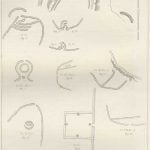The area which is embraced by works of this kind is very large: west of the Alleghanies it embraces the greater portion of the entire Mississippi valley, extending to Minnesota and the banks of many of its confluent streams. The valley of the Ohio appears to have been a favorite field of ancient occupancy. Its fertile soil; its mild climate; its varied resources; and its picturesque character and beauties, appear to have been as well appreciated and understood by its ancient as its present inhabitants. That its possession was coveted, that it was long cherished, and perhaps often fought for, is indicated by the large number of mounds and field-works, of various character, which have been disclosed by its modern settlement. The Valley of the Scioto appears, in particular, to have sustained a heavy ancient population, who left their altars, tumuli, and places of strong defense to attest a power and strength, which, we cannot hesitate to say, made Chillicothe its central capital. Whoever examines the full and accurate descriptions which have been given of its varied earth-works by Dr. E. H. Davis, assisted by Mr. Squier, and published in the first volume of the Smithsonian Contributions to Knowledge, must feel impressed either with the very ancient date of these remains, or with the great populousness of its fertile plains. Other parts of this stream, as at Marietta, Gallipolis, the Great Miami, and numerous minor sites, attest, by their monumental remains, the residence and reign of tribes having considerable power.
The long and fertile area of the American bottom opposite St. Louis appears to have been another central seat of this occupancy; and the relative positions of the Monk mound, and its satellite mounds, furnish, in some respects, a strong coincidence with the astronomical and astrological structures of the Toltecan race.
In Virginia, Kentucky, Tennessee, and along the borders of the lower Mississippi, the number of works of defense, and the strong idolatrous character of the ancient inhabitants, are denoted by other remains, which are seen to have covered large areas of-the most valuable and fertile portions of those states. Dr. Troost and Dr. Dickenson have exposed peculiar classes of facts.
These archaeological vestiges extend eastwardly, and then north-eastwardly from Mississippi and Louisiana, through Alabama, Florida, and Georgia, quite to South Carolina, where a work of this kind exists on the estate of the late Hon. John C. Calhoun, which is called Fort Hill. The Tuscaroras of North Carolina, in 1712, built a fort to defend themselves against the colonists under Colonel Moore, but it was not found efficient against field guns, and they were obliged to make an unconditional surrender.
It is not known that the small tribes of the Northern Atlantic fortified against an enemy, at least, that they erected any works of much or permanent importance, corresponding to those in the West.
Works of this character again appear in Western New York, in the ancient territories of the Iroquois, extending as far south as Auburn: they are seen on the highest and eldest ridge of land, extending through Erie and Chautauqua Counties to the portages of the Alleghany River. It is not apparent that all these works are of the same strong military character, and required as many hands to defend them, as the prime fortifications of the West; but they embrace the same principles, so far as they are carried out, and the sepulchral and general remains indicate the same era.
There is one feature, in which the works found in the West all agree. They evince a strong natural capacity for defense. They cover the highest points of land, and are so placed as to command its approaches. The form and size of the work to be adopted, was immaterial whenever a hilltop or plateau was occupied. It was walled or ditched in, according to its geological outlines. The principle of the bastion was secured by any heights or lands which commanded a length of wall or picketing. Traverses, generally resembling a segment of a circle, were drawn in front of the gates, sally ports, or openings. Small haycock mounds were, in other situations, erected to rake with missiles these entrances. The entrances themselves were sometimes of an oval or zigzag form. Difficulties of ingress, and facilities of issue, of a hand to hand force, were created by curved, or parallel lines, or by gaps, suitably defended.
Examples of each of these principles of the ancient fortification, as it exists in the Mississippi Valley, are given in the Smithsonian volume No. 1, to which we have alluded. They will be found described in the works at Bournville, (Plate IV. page 11), at Fort Hill, (Plate V. page 14), at Hamilton, Butler County, Ohio, (Plate VI. page 16), where the Tlascalan gateway is exemplified. On the Little Miami, (Plate VII. page 18), on the Great Miami, (Plate VIII. 1. 2. 3.) In Licking County, Ohio, (Plate IX. 1. 3. page 24), on Point Creek, (Plate X. page 26.) And by the accurate surveys depicted in Plates XI. to XV., respectively. These plates and descriptions secure the requisite degree of scientific accuracy.
The different modes in which a gateway or sally-port is covered, in these antique works, by traverses and mounds, is denoted by the following Plate, No. 4, Fig. 1. 2 3. 4. 5. 6. 7. 8. 9. 10. 11. 12.

